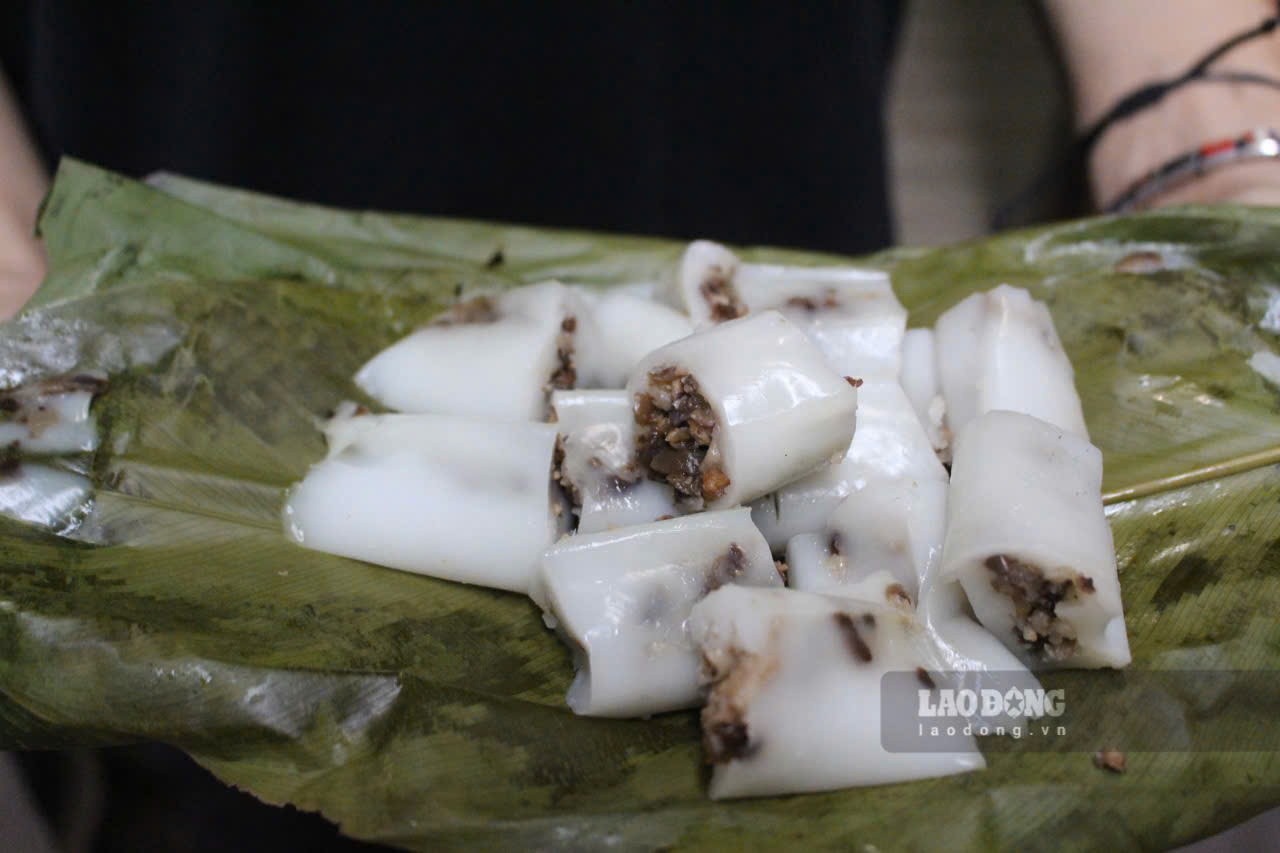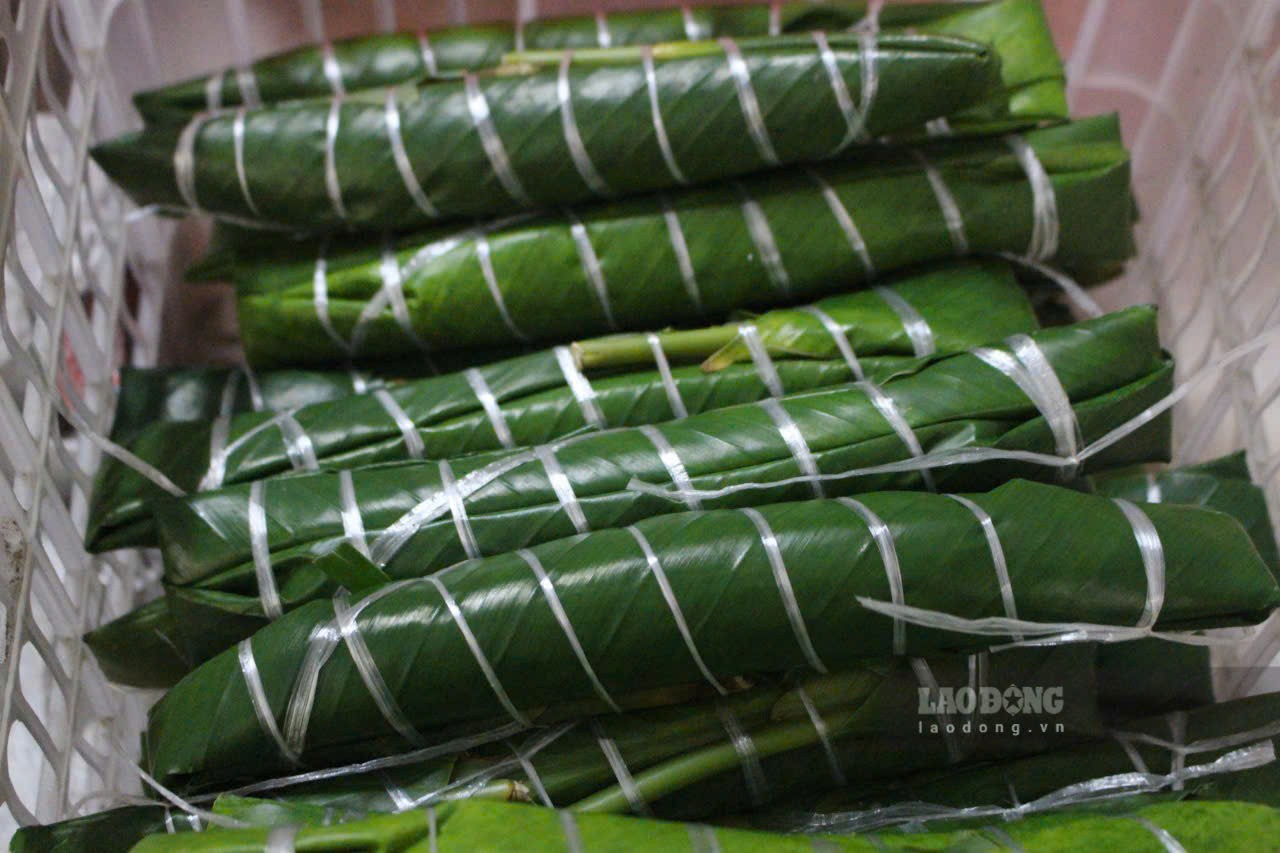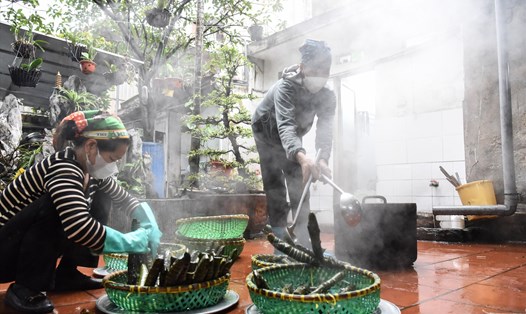Cho village's tea cake is not a luxurious, elaborate dish. It is as simple as the name, rustic as the true farmers who created the specialty of this countryside.
"Te cake is a dish that has been passed down from ancient times in the village. My family has been making cakes for 3 generations, and now we continue to make them without a day off, said Ms. Nguyen Thi Huan (58 years old, Cho village).
Her memories are her childhood days, ton can with her mother, learning how to wash rice, dry leaves... Starting to make cakes with her parents since she was a child, Ms. Huan said that the size of a cake on two fingers, the ingredients are simple but to make it, it takes many stages.
Tourists walking along the Cho village road will not have to find it difficult to see a familiar image in front of each bakery house. In front of the small front of Mrs. Huan's family's house, or like other households making banh tet in Cho village, there is always a small box filled with freshly steamed banh tet to retail to customers passing by the road. Every time there are many orders, there are many people in the house, and the rice and dong leaves are everywhere.
The banh tet consists of two parts: the crust and the filling. The cake crust is made from rice, delicious, long, and less sticky. It can be Khang dan rice, 203 or 70, soaked, ground, or filtered to get the flour. After the rice flour is available, the baker continues to mix the flour with the water at an appropriate ratio. "Before I had a machine, I had to pump the powder by hand. The smaller the ball, the more loose it is, the more flexible the cake is," said Ms. Huan.
When the cake flour is finished, it is stored in a pot, soaked for about two days, remove the sour water two to three times a day, then add clean water and stir well. Before making the cake, squeeze out all the water in the pot of flour, pour the flour into the pot and then heat over medium heat so that the cake flour is not cooked, and keep beating it with your right hand.
According to Ms. Huan, making banh tet is a process that requires a lot of effort and the highest technique. Each pot has about 30kg of flour, at peak times, she sells about ten pots a day. When wrapping, pay attention to the heat and flour so that the flour is not too soft, so that when wrapping the cake, it is round. The flour is "ripe", thick, and the dead and unripe are blown out.


The filling was also finished at the same time, simply with lean lean meat, pork fat, dried onions and spices. All after the ingredients are cooked together, not stir-fried, because according to Ms. Huan, this is "fresh fat and absorbs the spices". Before packing, the filling will be scooped out to reduce fat.
Dong leaves are wrapped in a clean package, drained and dried. Banh Te is wrapped in two leaves, the inner leaves are smaller than the outer leaves. Pack the cake so that the two ends are long, the middle is raised so that the cake looks like a crooked tooth. "The cake package must be clever so that the cake is beautiful and without tearing the leaves," said Ms. Nghiem Thi Phuong (71 years old) - a baker at Ms. Huan's family.
Banh tay long is often made with a banana rope. At Ms. Huan's family, the craftsmen can wrap up to 2,000 cakes/day. The wrapped cake is then put in a pot of boiling water, boiled for about 30 minutes, then taken away and drained. When cooked, the banh tet is slightly yellow, peeled off the leaves, giving off the occasional aroma of leaves and rice.
Once a traditional rustic gift used during holidays and Tet, Cho village cakes have today become a specialty loved by many diners inside and outside the province when traveling to Bac Ninh. From familiar ingredients, the people of Cho village with their ingenuity and special effects have transformed the cake into a small, pretty cake with a soft, sticky shell and rich meat and wood ear filling.
When biting a piece of cake, diners will immediately feel the delicate blend. The cake crust is soft and flexible but not stuck to the teeth, easily dissolved in the mouth. Next is the rich, fatty taste of the filling, the crunchy crunchy texture of the wood ear and the characteristic strong aroma of fried and pepper. Add a little delicious fish sauce with a few slices of chili, people eat one and want to eat two.
The ingredients and methods have been passed down from father to son, but today, to meet market demand, households making banh tet in Cho village have applied machines in some stages to increase productivity, ensuring even quality.
Cho village banh tet has not only "waited" for diners to visit the village but has also confidently "go" everywhere. Banh tet has been present at weddings, restaurants, hotels, and traveling to all provinces and cities from North to South. Since then, this rural cake has brought a good income to many households who are still diligently defending the traditional craft of Cho village.











